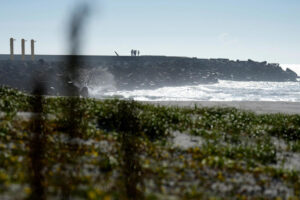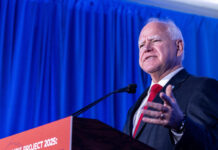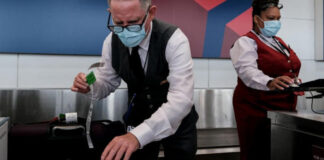AUGUST 24, 2023

Journalists film the Fukushima Daiichi nuclear power plant, damaged by a massive March 11, 2011, earthquake and tsunami, from the nearby Ukedo fishing port in Namie town, northeastern Japan, Thursday, Aug. 24, 2023. The Fukushima Daiichi nuclear power plant will start releasing treated and diluted radioactive wastewater into the Pacific Ocean as early as Thursday. (AP Photo/Eugene Hoshiko)
OKUMA, Japan — The operator of the tsunami-wrecked Fukushima Daiichi nuclear power plant says it has begun releasing its first batch of treated radioactive water into the Pacific Ocean — a controversial step, but a milestone for Japan’s battle with the growing radioactive water stockpile.
In a live video from a control room at the plant Thursday, Tokyo Electric Power Company Holdings showed a staff member turn on a seawater pump, marking the beginning of the controversial project that is expected to last for decades.
“Seawater Pump A activated,” the main operator said, confirming the release was underway. TEPCO later confirmed that the seawater pump was activated at 1:03 p.m., three minutes after the final step began.
Japanese fisher groups have opposed the plan for fear it will further damage to the reputation of their seafood. Groups in China and South Korea have also raised concern, making it a political and diplomatic issue.
Fukushima radioactive material release: Japan can release Fukushima water from tanks with radioactive material, UN says
But the Japanese government and TEPCO say the water must be released to make room for the plant’s decommissioning and to prevent accidental leaks. They say the treatment and dilution will make the wastewater safer than international standards and its environmental impact will be negligibly small. But some scientists say long-term impact of the low-dose radioactivity that remains in the water needs attention.
The water release begins more than 12 years after the March 2011 nuclear meltdowns, caused by a massive earthquake and tsunami. It marks a milestone for the plant’s battle with an ever-growing radioactive water stockpile that TEPCO and the government say have hampered the daunting task of removing the fatally toxic melted debris from the reactors.
The pump activated Thursday afternoon would send the first batch of the diluted, treated water from a mixing pool to a secondary pool, where the water is then discharged into the ocean through an undersea tunnel. The water is collected and partly recycled as cooling water after treatment, with the rest stored in around 1,000 tanks, which are already filled to 98% of their 1.37-million-ton capacity.
Those tanks, which cover much of the plant complex, must be freed up to build the new facilities needed for the decommissioning process, officials said.
Prime Minister Fumio Kishida said it is indispensable and and cannot be postponed. He noted an experimental removal of a small amount of the melted debris from the No. 2 reactor is set for later this year using a remote-controlled giant robotic arm.
TEPCO executive Junichi Matsumoto said Thursday’s release was to begin with the least radioactive water to ensure safety.
Final preparation for the release began Tuesday, when just one ton of treated water was sent from a tank for dilution with 1,200 tons of seawater, and the mixture was kept in the primary pool for two days for final sampling to ensure safety, Matsumoto said. A batch of 460 tons was to be sent to the mixing pool Thursday for the actual discharge.
But Fukushima’s fisheries, tourism and economy — which are still recovering from the disaster — worry the release could be the beginning of a new hardship.
Fukushima’s current fish catch is only about one-fifth its pre-disaster level, in part due to a decline in the fishing population. China has tightened radiation testing on Japanese products from Fukushima and nine other prefectures, halting exports at customs for weeks, Fisheries Agency officials said.
In 2021, the Japanese government announced plans to release the treated water to the sea. Then, on Sunday, Kishida made a rushed visit to the plant before meeting with fisheries representatives and pledging to support their livelihoods until the release ends.
The rushed timeline raised skepticism that it was made to fit Kishida’s busy political schedule in September. But Economy and Industry Ministry officials say they wanted the release to start as early as possible and have good safety records ahead of the fall fishing season.
The March 2011 earthquake and tsunami destroyed the plant’s cooling systems, causing three reactors to melt. Highly contaminated cooling water applied to the damaged reactors has leaked continuously to building basements and mixed with groundwater.
TEPCO plans to release 31,200 tons of the treated water by the end of March 2024, which would empty only 10 tanks because of the contaminated production of wastewater at the plant, though the pace will later pick up.































































































